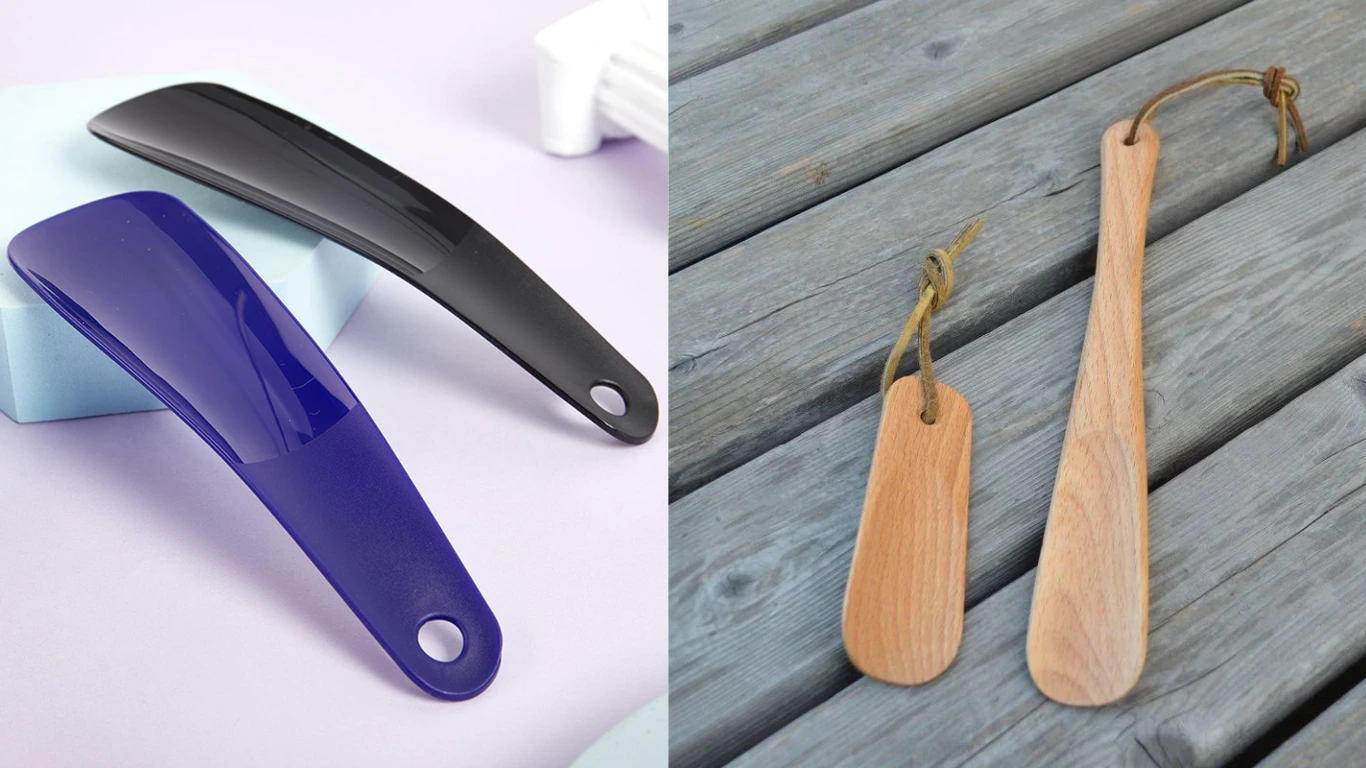When it comes to shoe horns, the choice between plastic and wood is a crucial one. The right shoe horn can make slipping into your favorite pair of shoes a breeze, but the material you choose can significantly impact your experience.
In this guide, we’ll explore the world of shoe horns and help you determine whether plastic or wood is the perfect fit for your needs.
Understanding the Purpose of a Shoe Horn
Before we dive into the plastic vs. wood debate, it’s essential to understand the primary purpose of a shoe horn. A shoe horn is a simple yet incredibly effective tool used to slide your heel smoothly into tight-fitting shoes without causing any damage, either to the shoes themselves or to your feet.
Shoe horns work by reducing the friction and pressure required to put on shoes, evenly distributing the force along the shoe’s heel counter. This not only prevents damage to the shoe but also protects your Achilles tendon. The horn-shaped handle allows you to securely hook the heel of your shoe, guiding your foot in effortlessly.
The Pros and Cons of Plastic Shoe Horns
Pros of Plastic Shoe Horns
Durability: Plastic shoe horns are made from robust polymers, making them highly durable and resistant to cracks and breaks. With proper care, a quality plastic shoe horn can last for years.
Lightweight: Weighing just a few ounces, plastic shoe horns are extremely lightweight and comfortable to handle, making them an excellent choice for everyday use.
Affordability: Simple plastic shoe horns are widely available at an affordable price, often costing just a couple of dollars per horn.
Variety of Designs: Plastic shoe horns come in a wide selection of styles, ranging from basic models to those with ergonomic handles. Some even feature travel caps or fun colors, allowing you to choose one that matches your style.
Easy Maintenance: Keeping plastic shoe horns clean is a breeze. They only require an occasional wipe down with a damp cloth to stay in pristine condition.
Cons of Plastic Shoe Horns
May Feel Flimsy: If the plastic is too thin, some plastic shoe horns can feel flimsy, which may affect their overall durability.
Risk of Scratching: Although designed to be smooth, some plastic shoe horns may scratch or scuff delicate shoe materials if not perfectly smooth themselves.
Aesthetic: Plastic shoe horns may not have the same elegant aesthetic appeal as their wooden counterparts.
The Pros and Cons of Wooden Shoe Horns
Pros of Wooden Shoe Horns
Smooth Finish: Wooden shoe horns are crafted from sanded and treated wood, ensuring they have a perfectly smooth surface that won’t scuff your shoes.
Sturdy: Dense, high-quality wood provides substantial support and prevents bending when in use, making wooden shoe horns highly reliable.
Warmth: Wooden shoe horns tend to retain less cold than plastic when coming out of storage, providing a more comfortable experience, especially during colder seasons.
Sophisticated Style: Wooden shoe horns exude an elegant, sophisticated look, making them a stylish accessory for any shoe collection.
Environmentally Friendly: Sustainably sourced wood used for shoe horns is biodegradable and renewable, making them an environmentally conscious choice.
Unique: Natural variations in wood grain ensure that each wooden shoe horn is distinct and carries a touch of uniqueness.
Cons of Wooden Shoe Horns
Prone to Scratches: Over time, the wood finish on these shoe horns can get scratched or damaged.
Requires Maintenance: Wooden shoe horns need periodic conditioning with beeswax or mineral oil to maintain their appearance and functionality.
Higher Cost: Due to the craftsmanship and materials involved, wooden shoe horns typically come at a higher price point, ranging from $10 to $30.
Not Travel-Friendly: Wooden shoe horns are less durable and heavier, making them less suitable for travel.
Key Considerations for Choosing Your Perfect Shoe Horn
Your decision between plastic and wood shoe horns should be based on several key factors:
Budget: If you’re on a tight budget, basic plastic shoe horns offer better value. However, if you’re looking for a luxury item, wood is the way to go.
Aesthetic Preference: Consider whether you prefer the elegant look of wood or the modern design of plastic.
Intended Usage: Will you be using the shoe horn frequently or primarily for travel? Plastic shoe horns are more durable for heavy or frequent use.
Shoe Material: Delicate leathers and suedes require the perfectly smooth surface of a wooden shoe horn to avoid scuffs.
Maintenance: Are you willing to invest time in periodically conditioning your shoe horn? If not, plastic may be the lower-maintenance option.
Environmental Impact: If sustainability is a concern, wooden shoe horns are a more environmentally friendly choice. Plastic, however, is more easily recyclable.
Here is a simple table comparison for your easy guide.
| Feature | Plastic Shoe Horns | Wooden Shoe Horns |
|---|---|---|
| Durability | Highly durable | Sturdy |
| Weight | Lightweight | Heavier |
| Affordability | Affordable | Higher cost |
| Aesthetic Appeal | Modern | Elegant |
| Maintenance | Low maintenance | Requires upkeep |
| Environmental Impact | Less sustainable | Eco-friendly |
| Suitability for Travel | Durable for travel | Less travel-friendly |
This simple comparison table summarizes the key differences between plastic and wooden shoe horns in terms of various features and attributes.
Conclusion: Finding Your Perfect Shoe Horn
In the end, the right shoe horn choice boils down to your planned usage, your shoe wardrobe, and your personal preferences regarding cost, style, and convenience. Think about where and how often you’ll use your shoe horn to make the optimal choice between plastic and wood.
With proper selection and care, your new shoe horn will become an invaluable tool, ensuring pain-free shoe wearing for years of daily use. Whether you opt for the durability of plastic or the timeless elegance of wood, your choice will ultimately enhance your shoe-wearing experience.
